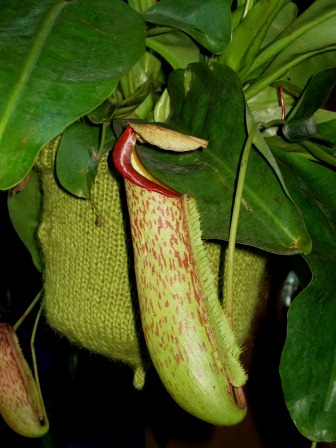Friday’s puzzle was tough! Several of you were on the right track – this is a carnivorous plant. Right away Deb suggested a pitcher plant (then got sidetracked with chestnuts), but Derek was spot on with his guess of the “spiky bits” on a Nepenthes pitcher:

What the function of these spiky wings are is not clear to me; I did a little checking in the literature but failed to find anything convincing. It does seem to suggest a close relationship with fly traps. Perhaps the ancestral type was a fly trap type plant, which eventually evolved to an enclosed pitcher? (Perhaps someone out there has a better grasp of carnivorous plant evolution than I do?)
And the scientific name? Nepenthes alata, or “winged Nepenthes.”
Thanks for playing!
I have a carnivorous plant book at home. I’ll have to look up the ancestry of the Nepenthes. I know it’s not at all related to Venus flytraps, which have evolved from sundews. Carnivorous plants have two different types of traps, passive and active. Nepenthes, Sarracenia, and others are considered passive. VFT, sundews, and bladderworts are examples of active, where prey is actively caught by the plant. Sundews are actually a gray area. They rely on the sticky secretions to catch the insects, but the “hairs” where the insect are caught will slowly roll up around the caught insect. Here’s a website with lots of good info. Interesting guy running the place. http://www.pitcherplant.com/
Anyone familiar with Lewis Ginter Botanical Garden in Richmond, VA, he provided the Sarracenia for their gardens.
Is it planted in a sock?
Ed, thanks for the links. And yes, though Venus fly traps aren’t related to Nepenthes, I’m wondering if Nepenthes’ ancestors perhaps were similar types of traps (convergent evolution) that fused along the edges, leaving the spiky wings as a remnant.
Deirdre, I don’t know WHAT this thing is! They were all over the place at the show – little knit pot covers. I don’t know if it’s supposed to be an aesthetic improvement, or whether it has a diaper-like function. No clue.
Woot! I recognized them right away because I’ve always wondered why they were there, especially because some Nepenthes have them and some do not.
Perhaps the spikey wings a “ant ladders”, allowing easy access to the lip to moribund insects.
About the knitted thingy… Knitters will knit anything. It’s a pot cozy, similar to a teapot cozy (see http://blog.craftzine.com/2169712559_259e12bacf.jpg or see http://busstop.typepad.com/blog/images/tree_sweater_1.jpg). It won’t hold water, so no worries about drainage.
Those wings have nectar glands on them to guide insects up into the trap. They can also serve as ladders although that is not their primary function.